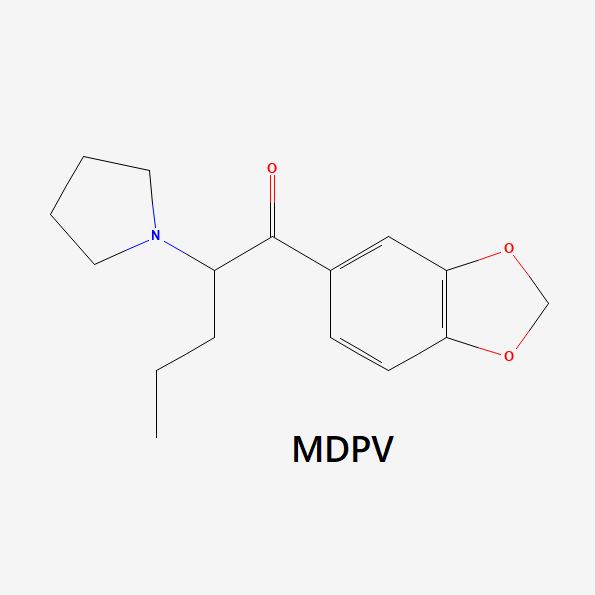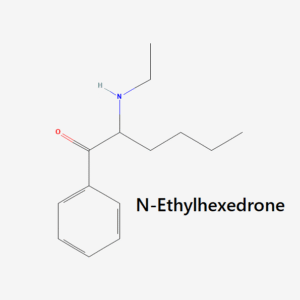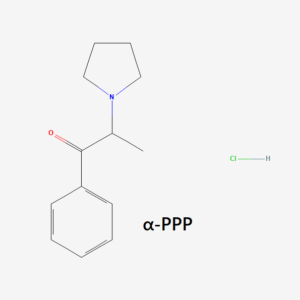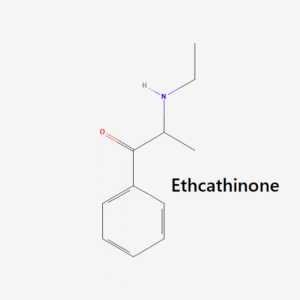Metabolism
MDPV’s metabolic process is mediated by the CYP450 system, specifically the 2D6, SC19, and 1A2 enzymes [1], and occurs in the liver, where the transformation method is COMT phase 1 metabolism. It is transformed into methylcatechol and pyrrolidine, which in turn are glucuronated (uridine 5′-diphospho-glucuronosyl-transferase), allowing the products to be excreted by the kidneys, with only a small fraction of the metabolites being excreted into the stools. No free pyrrolidine is detected in the urine [2].
Molecularly, this is seen as demethylenation of methylenedioxypyrovalerone, followed by methylation of the aromatic ring via catechol-O-methyl transferase. Hydroxylation of both the aromatic ring and side chain then takes place, followed by oxidation of the pyrrolidine ring to the corresponding lactam, with subsequent detachment and ring opening to the corresponding carboxylic acid.
4-OH-3-MeO-PV is the major metabolite found in urine samples from rats and humans exposed to MDPV administration.
Duration of Effects
According to the DEA, MDPV’s effects have a duration of three to four hours, with the after-effects lasting another three to four hours. Adverse effects like tachycardia, hypertension, sweating, and vasoconstriction usually last up to six to eight hours after administration.
How Does MDPV Work?
Substituted cathinones like MDPV work by affecting the neuropharmacology of neuronal transporters like dopamine and serotonin through three basic mechanisms:
- Some block the reuptake of neurotransmitters
- Some block the clearance of neurotransmitters
- Some reverse the polarity of neurotransmitter transporters
Inside the body, the reality is, of course, far more complex: typically, psychostimulant compounds will utilize more than one mechanism, and differences in receptor affinities also come into play. Simply stated, the more in-depth we go into the neuropharmacology of these products, the more differences we can find, but that being said, there is still a high degree of similarity between them.
Psychostimulant amphetamines utilize a combination of different methods, but they all achieve the same goal — an increased level of active neurotransmitters within the brain.
Primarily, MDPV is classified as a norepinephrine–dopamine reuptake inhibitor (NDRI). Research has found that its activity at the dopamine transporter is six times stronger than at the norepinephrine transporter, and it is virtually inactive at the serotonin transporter [3]. This would make MDPV almost an exclusively dopaminergic drug, which accounts for its marked emphasis on stimulant properties.
In vivo, studies have revealed that, when compared to the prototypical uptake inhibitor cocaine, MDPV is 50 times more potent as an inhibitor of dopamine (DAT), 10 times more potent at norepinephrine receptors (NET) and tenfold less potent at serotonin receptors (SERT). It was also found that unlink other compounds in its class, like 4-MMC and methylone, MDPV does not act as a substrate for monoamine transporters, meaning that it does not have the capability to stimulate the release of neurotransmitter molecules from presynaptic neurons – a secondary mechanism of action present in many psychostimulants [3].
These findings for MDPV’s pharmacology are quite interesting as it appears to have basically no secondary mechanisms acting as a “pure” reuptake inhibitor. What’s more, MDPV’s affinity for serotonin is not significant, while action at secondary sites like adrenergic receptors is non-existent. In this sense, MDPV is also a purely dopaminergic drug.
MDPV Pharmacokinetics
Given the importance of pharmacokinetics (PK) in the forensic detention and evaluation of NPS, there is a good amount of research on the subject, although mostly in rat studies.
Like other drugs in its class, MDPV’s PK values were rapid. In rats, maximal plasma concentrations occurred within 15 to 20 minutes after injection and decreased quickly thereafter. Upon injection of 2 mg of MDPV, the plasma Cmax for the drug is 271 μg/L (~1 μM), and the elimination half-life is about 80 minutes. Plasma concentrations for the metabolites, 3,4-catechol-PV and 4-OH-3-MeO-PV, increased at a much slower rate, with maximum concentrations being reached in three to four hours post-injection [4].
It was also found that plasma MDPV concentrations display linear dose-proportional kinetics. This was surprising for researchers, as similar drugs like MDMA, through sustained inhibition of CYP enzymes, have been shown to accumulate in humans in a more exponential rather than linear fashion [4].
When experimenting with different methods of administration on rats, researchers recorded different PK values. This gives scientific backing to the recreational behavior often seen in relation to psychostimulant use, in which users will utilize a variety of methods, like snorting and “bombing,” in order to achieve both short and long-lasting effects. However, in the methods utilized by researchers, PK values always remained relatively fast, suggesting the efficacy of utilizing different methods is limited.
What Are the Effects of MDPV?
Substituted cathinones are well-known stimulants. Users often describe them as being similar to cocaine but with a little pinch of MDMA thrown in there.
For a drug like MDPV, the scientific literature suggests that action at the serotonin receptor – linked to empathogenic and psychedelic properties – is so small that there should be little comparison in terms of the subjective feeling when compared to the stimulant properties. However, user reports consistently express that MDMA-like qualities are present, albeit to a much lower extent.
Is MDPV Safe? Risks & Side Effects
MDPV is classified in the Controlled Substances Act (CSA) as a Schedule I substance, meaning it has no medicinal value and presents a high potential for abuse and dependence. In general, MDPV seems to present largely the same danger as other compounds in its class, but there are some individual characteristics that make its risk profile unique.
MDPV is one of the most potent compounds in its class, which has the immediate effect of making it more dangerous. Its elevated potency entails a narrow dosage window, which means that taking just a little bit too much can lead to psychosis, heart failure, stroke, or permanent brain damage.
Legal Status of Alpha-PIHP Hydrochloride
International Regulations
The legal status of Alpha-PIHP Hydrochloride varies globally. Many countries have classified it as a controlled substance due to its potential for abuse and harm. For instance, in the United States, alpha-PIHP is listed under the Controlled Substances Act, making its production, distribution, and possession illegal without proper authorization.
National and Local Laws
Different countries and regions have specific regulations regarding A-PIHP HCl. In Europe, it is controlled under the NPS (New Psychoactive Substances) framework, with individual countries enacting their own laws to restrict its availability. Similarly, in Asia, several countries have taken steps to ban or regulate the substance.
Enforcement Challenges
Despite legal restrictions, enforcing laws related to alpha-PIHP can be challenging. The rapid evolution of synthetic drugs means that new variants can emerge, often circumventing existing regulations. This ongoing battle requires constant updates to legal frameworks and international cooperation to address the issue effectively.
Conclusion
Alpha-PIHP is a potent synthetic stimulant with significant risks and legal implications. Understanding its effects, risks, and legal status is crucial for both users and policymakers. As synthetic drugs continue to evolve, staying informed and cautious is essential to mitigate the potential harm associated with substances like A-PIHP HCl.
By increasing awareness and education about alpha-PIHP, we can better navigate the challenges posed by synthetic stimulants. If you or someone you know is struggling with substance use, seeking professional help is imperative to ensure safety and well-being.




Reviews
There are no reviews yet.